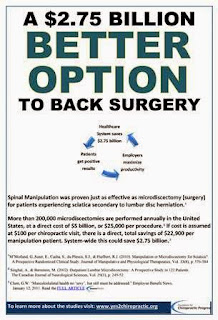“To the best of our ability, Life in Motion Chiropractic and Wellness agrees to provide our patients convenient, affordable, and mainstream Chiropractic care. We will not use unnecessary long-term treatment plans and/or therapies.”
| www.Chiro-Trust.org |
At Life in Motion Chiropractic and Wellness we practice
evidence based medicine which is:
“The conscientious, explicit, and judicious use of
current best evidence in making decisions about the care of individual
patients. The practice of evidence based medicine means integrating individual
clinical expertise with the best available external clinical evidence from
systematic research.”
And therefore we utilize outcome measures such as:
• Oswestry Back Pain Disability Index (ODI)
• Keele STarT Back Screening Tool
• Neck Disability Index (NDI)
• Functional & Visual Analog Pain Scale(s)
• DASH Questionnaire
• Headache Disability Index
In order to show that the treatment given was
reasonable and necessary as well as determine when the patient’s clinical
status has reached maximum improvement.
 |
| Evidence Based Medicine |
ChiroTrust™ members are a group of Doctors of Chiropractic worldwide who have taken “The ChiroTrust Pledge” (See Above) and are dedicated to providing conservative, mainstream chiropractic care to patients without sales pressure, long-term recommendations, unnecessary therapies or excessive costs.





